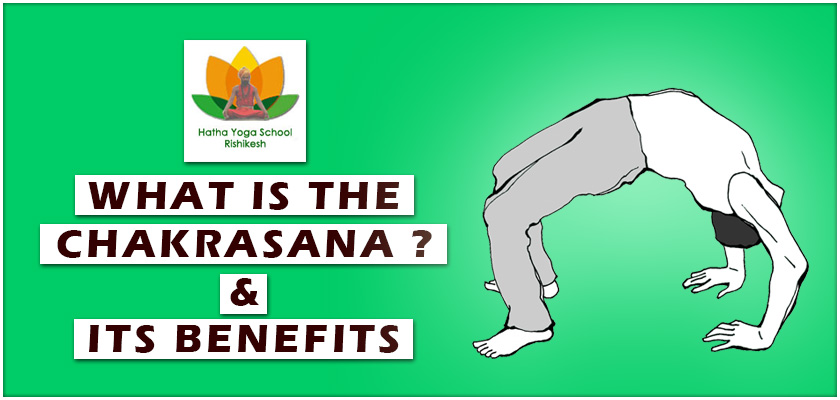What is Chakrasana
“Chakrasana” comes from the Sanskrit words “Chakra” which means “Wheel” and “asana” means “. “Pose”, so it is known as Wheel Pose. Because the body forms the shape of a wheel when in the posture. Chakrasana is also known by an alternative Sanskrit name “Urdhva Dhanurasana”, which means upward-facing bow pose. It is most popular for the strong back-bending yoga asana and It is so famous in many forms of yoga and is part of the primary series of Ashtanga yoga. This asana gives great flexibility to the spine.

Chakrasana is the best yoga asana pose for stress relief and peaceful mind. Chakrasana or Wheel Pose is one of the yoga poses to balance the Chakras in the human subtle body. To get the stress relief life yoga student join yoga teacher training center in Rishikesh and learn different types of yoga asana to acquire a peaceful mind. In this chakrasana, a person lies down flat on the ground and then raises his body upwards. Here, we are sharing the step by step process for how to do Chakrasana, precautions and chakrasana benefits.
Tips for Yoga Beginners to do Chakrasana
For beginners, this pose can be quite challenging, so they ensure that their body has enough flexibility to perform this chakrasana. To perform this asana, you always try some simple poses to improve the flexibility of the pose and gaining the steadiness and flexibility. When you try to do this asana, you will find your feet and knees splaying as you lift your body to assume this pose. And so it will lean to compress your lower back.
Precautions to do Chakrasana (Wheel Pose)
- If you have any back injury, then you do not try this Chakrasana.
- If you are suffering from a heart problem, then you should avoid this asana.
- If you are suffering from Diarrhoea, headache, carpal tunnel syndrome, then avoid this asana.
- High or low blood pressure patient always try to avoid this asana.
- If you are suffering from any cardiac or spinal problems then avoid this asana.
- If you have tendonitis in your wrists then you should avoid this asana.
How to do Chakrasana
To learn how to do Chakrasana, just follow the steps:
- To start this chakrasana, firstly lie flat on your back with feet apart.
- Now bend your both knees and place your feet flat on the floor near your buttocks.
- After this, place your palms under your shoulders with the fingers pointed towards the shoulders and the elbow shoulder-width apart.
- Now, slowly inhale and press your palms on the floor. And lift your shoulders and head off the floor by straightening your arms.
- You can find that the feet should be pressed firmly into the floor. Inhale and lift your hips up. The spine should be rolled up so that it may seem to resemble a semi-circular wheel.
- Now straighten out your arms and legs as much as possible so that the hips and chest may be pushed up.
- You should hold this pose for at least 15-30 seconds.
- To back to your original pose, bend your elbows to lower your head and shoulders to the floor. Then bend your knees and bring your spins and hips back to the ground.
- Doing this yoga asana, you should take a lot of relaxing to your body.
Benefits of Chakrasana
- This chakrasana gives your lungs and chest a good stretch and also expands the shoulders and the chest.
- This asana helps to increase the elasticity of the spinal cord.
- Chakrasana is very useful in treating diabetes, asthma, constipation, and obesity.
- This asana has a positive effect on hormonal secretions.
- Chakrasana is recommended for those people who are suffering from digestive or respiratory disorders.
- It is very beneficial for your cardiovascular, glandular and nervous system health.
- The asana boosts energy and alleviates depression.
- This asana reduces the stress and tension in the body and eyesight becomes sharp.
- Chakrasana rectifies the uterine and menstrual problem in women.
- This asana reduces the fat and muscles in the abdomen area and tones the process of the digestive and reproductive organ.
